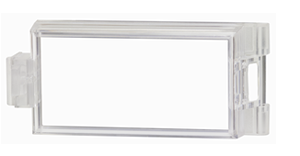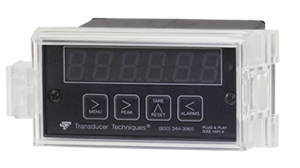Transducer Techniques Introduces the New DPM-3-SPC Splash Proof Cover

CAL-TEDS Plug & Play Smart Sensors

DPM-3-SPC Splash Proof Cover

DPM-3-SPC Splash Proof Cover Attached

DPM-3-SPC Splash Proof Cover Specifications
Transparent, impact-resistant, dustproof, and waterproof this cover will protect the front of the DPM-3 Digital Panel Meter Display.
TEMECULA, CALIFORNIA, UNITED STATES, April 7, 2021 /EINPresswire.com/ -- The DPM-3-SPC is a rugged, impact resistant, clear, dust, and waterproof cover that fits over a 1/8 DIN instrument to seal the front of the load cell display panel from the elements.The DPM-3-SPC meets NEMA 12 (IP52) standards for water splash and dust protection when the hinged door is fully snapped in place. The DPM-3-SPC meets NEMA 4 (IP67) standards for hose-directed water when the hinged door is further clamped down with the provided plastic locking key.
A capillary seal is formed between the door and the base by a tapered recess in the door and a tapered ridge in the base. The capillary action causes a small amount of water to be drawn in between the two surfaces, thereby producing a water-tight film around the sealing area. For applications where fluid residues not acceptable, such as food processing, apply a light coating of clear IPC Overview silicone grease, or other approved sealant, to the mating grove to prevent any ingress of liquid and enable the cover to withstand steam cleaning.
The DPM-3-SPC door is latched against the base by a locking tab when the door is snapped shut. Positive clamping of the door and protection against opening of the locking tab by hose-directed water are provided by a locking key, which remains in place to provide a much higher clamping force than the tab alone. Model DPM-3-SPC fits the DPM-3 Digital Panel Meter, our TEDS compatible Load Cell or Torque Sensor Display, as well as other 1/8 DIN instruments by other manufacturers, provided that the instrument dimensions in front of the panel do not exceed 48 x 96 x 15 mm (1.89" x 3.78" x 0.59"). It can be purchased as an add-on option for new instruments or be fitted to existing installations.
Learn more facts and specifications from our website.
https://www.transducertechniques.com
Transducer Techniques, established in 1979, designs and manufactures a complete line of load cells, torque sensors, special purpose transducers and related instrumentation. Transducer Techniques load cells are uniquely designed for weight and force measurement in such diversified applications as process control and factory automation. Other applications exist in numerous fields of science and industry for our load cells. All transducer sensing elements incorporate bonded foil strain gauges, wired in a full Wheatstone bridge configuration.
Technology
Load cells are electro-mechanical transducers that translate force or weight into voltage. This change in voltage produces a signal in the read-out instrumentation, a repeatable deflection or indication that can be calibrated directly in terms of the load applied to the load cell.
Construction
Construction of the load cell utilizes all the advantages of bonded foil strain gauges. Sealed within the load cell are sets of matched strain gauges bonded to a high strength element, machined to close tolerances. The strain gauges are electrically connected to form a balanced Wheatstone bridge and additional compensation resistors are added to the circuit for maintaining the accuracy of the bridge over a wide temperature range.
Operation
The principle of operation depends upon the deflection of the strain gauge filament, creating a change in its resistance, thereby unbalancing the bridge circuit. As a result, for a given input voltage, the output voltage of the bridge varies proportionally with the load and the change can be read on appropriate instrumentation.
Quality
When completed, each load cell is individually tested and calibrated. Each cell must meet or exceed rigid electrical and mechanical performance tests before it is released for service. Also, every cell is proof tested to its full rated capacity, and in most instances, to over its rated capacity.
Attributes
An important asset of our load cells is their extremely small deflection. The maximum deflection of standard cells does not exceed .012" at full load. This plus the fact that these load cells contain no moving parts opens unlimited application fields. The inherent compactness of the load cells minimizes installation problems.
The frequency response characteristics of our load cells are exceptionally good. The relatively low mass, and the small deflection under load, result in a high-frequency response which emphasizes the use of the load cells in many services where other transducers cannot perform.
Only strain gauges of the highest quality are installed and configured by technicians who have undergone our extensive training program targeting craftsmanship and attention to detail. To the end-user, this means a quality product. All Load Cells / Force Sensors and Torque Sensors are supplied with a Calibration Certificate traceable to NIST.
Customer Support
Transducer Techniques, LLC
+1 800-344-3965
email us here
Visit us on social media:
Facebook
Twitter
Legal Disclaimer:
EIN Presswire provides this news content "as is" without warranty of any kind. We do not accept any responsibility or liability for the accuracy, content, images, videos, licenses, completeness, legality, or reliability of the information contained in this article. If you have any complaints or copyright issues related to this article, kindly contact the author above.
